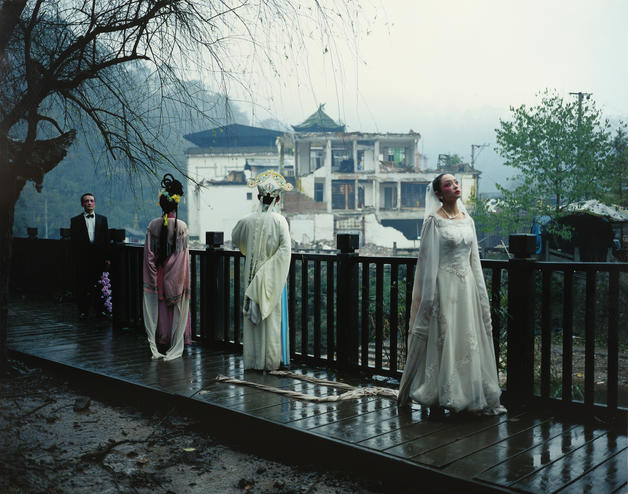Chen Qiulin, Twilight, 2009, Photograph 48.8 x 60.6 in / 124 x 154 cm. October 28, 2019 https://www.sothebys.com/en/articles/chinese-elements-at-2013-art-basel-hong-kong
Chen Qiulin’s photograph, Twilight, is a piece of performance art that displays the photographer’s discomfort with the decayed environment. To support her claim, Chen Qiulin focuses on the eroding surroundings and destroyed landscape. She illustrates both concepts through the composition of the traditional and modern figures and their points of view. (revision and editing have made the paragraph sound clear and beautiful!)
Focusing on urbanization, Qiulin shows the eroding traditional surroundings through both the position of the historical figures regarding the demolished house and their vision. In the background, Qiulin presents a partially demolished traditional family house. She purposefully locates the traditional figures in front of the house and makes them face the dilapidation in order to express disappointment in urbanization. According to their distinct dress, they are deemed descended from heaven and searching for the house they used to call home. However, the views frustrate them as their beloved home is demolished and will soon become ruins and rubble. Positioning the traditional figures in front of the dilapidated house, Qiulin expresses nostalgia for the cultural and architectural disappearance under urban modernization.
Aside from the composition, the point of view of the traditional characters leads the viewers to further consider toward the aftermath of demolition. In the traditional views, the landscapes represent a philosophical notion of harmonious relations between humans and nature, like a woman’s body with aesthetic beauty essential to the built environment. However, this traditional aesthetic collapses as the scale of urbanization behaves like an aggressive man, violently assaulting the land and leaving the woman with a wounded body. The artist’s subjective insertion of a traditional perspective on contemporary destruction questions today’s economic frenzy from a historical perspective. (turn this into topic sentence?)
In order to present the aftermath of the earthquake, Qiulin presents the destroyed landscape through the position and perspectives of the modern figures within the photograph. Qiulin intentionally places the woman wearing a western bridal gown at the foreground and the man in a tuxedo in the background. Though they are dressed for their wedding, they are far apart from each other. The two people seem shocked and bemused by the earthquake and do not know where to go or how to find each other. Deliberately separating the couple, Qiulin illustrates the psychological impact people suffered from the physical change of the environment associated with the earthquake.
Aside from the composition, the modern characters’ point of views leads the viewers to further consider the aftermath of the earthquake. The contemporary characters gaze into space beyond the frame, suggesting a sense of uncertainty and ambiguity. From the glazed look and sullen facial expressions of the two characters, they seem to look at the destruction and damage done. Maybe their wedding place has turned into ruins. Maybe their relatives have become the victims of the disaster and lost their lives. The ambiguity of their perspective reflects the artist’s unease about the unpredictability of nature as the earthquake overthrows the balance between humans and nature.
What are the causes of the decayed environment? Whom should we blame? Interpreting from Qiulin’s portrayal, I believe we, humans, should take full responsibility for destroying the past cultural heritage and blurring the goal for future development. The urban modernization has caused the eroding surroundings. In order to reach urbanization and gain economic benefit for itself, the government neglects the past cultural architectures and chooses to demolish buildings unhesitatingly. The destroyed landscape seems caused by the inevitable natural disaster, but it is related to the jerry-built construction. In order to reach the deadline assigned by their demanding employers, workers have no choice but to rush the construction process without paying attention to the housing quality. As a result, these low-quality houses easily collapse in earthquakes and takes the lives of many people. The damage could have been lessened if the houses are built following standards. As a result, humans have destroyed the past and shattered the identity of the landscape. The future for the homeland will be unclear since the land’s identity has been lost. No one knows what should be constructed anymore.
Overall, Chen Qiulin presents the decayed homeland by focusing on both the demolished surrounding in terms of modernization and destroyed landscape in terms of the earthquake. Qiulin demonstrates these two types of landscapes through the composition of the figures and their points of view. The image reflects modern China’s negligence toward cultural architecture and the contemporary construction process. She invites conversation and contemplation on the role humans play in our environment, whether built or natural. As a viewer, I feel disheartened about the way we choose to blindly move forward and ignore the standards, leading to the loss of identity and punishment from nature. I hope this artwork alarms people into seeing the damage they have done and prevent any future landscape from being destroyed. (a strong conclusion)

